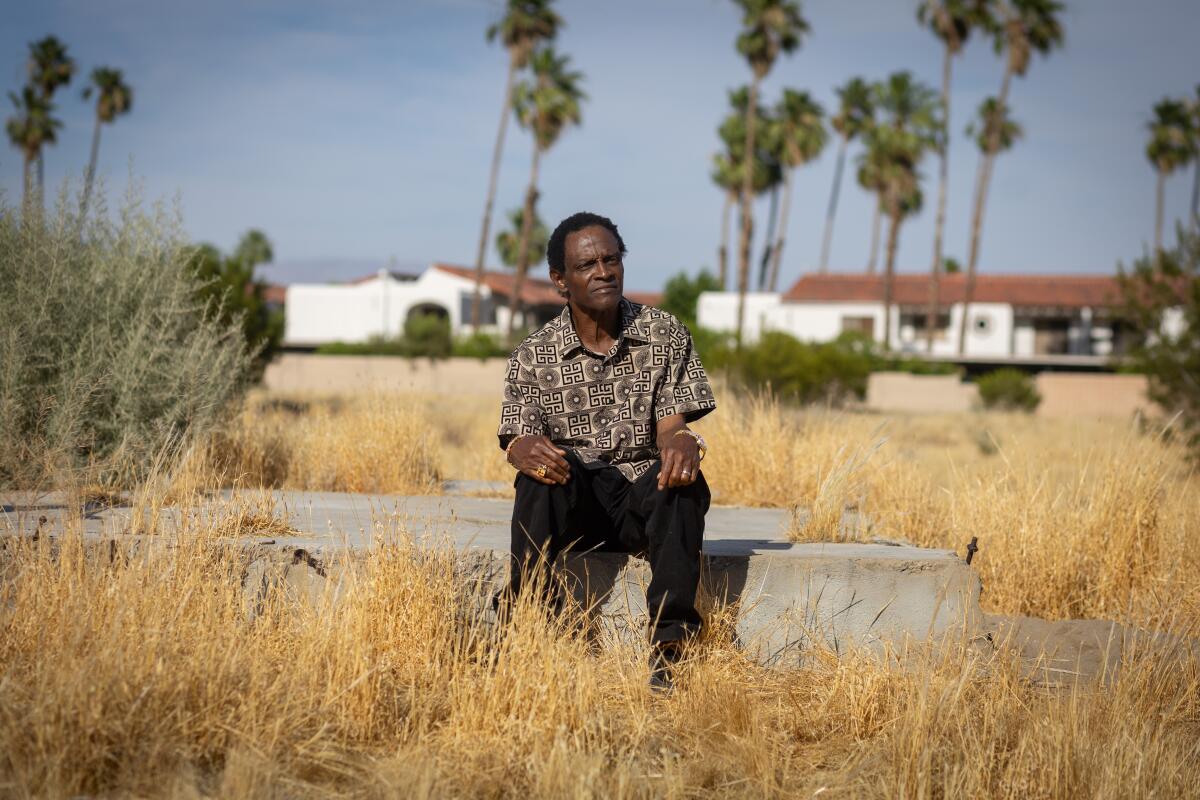Palm Springs to pay $5.9 million to Black and Latino families over razed homes

- Share via
PALM SPRINGS — The Palm Springs City Council has unanimously approved a $5.9-million settlement with the Black and Latino families whose homes were razed and burned in a brutal urban renewal project in the 1950s and 1960s.
A standing-room crowd in the City Hall chambers Thursday night exploded into clapping and cheering, leaped to their feet and embraced.
“I feel like I can breathe finally,” said Pearl Devers moments after the vote. The Section 14 survivor called the settlement “a beacon of hope” for people across the world.
“What happened here should happen around the world,” she said. “This is just the beginning.”
The settlement package includes compensation based on the current value of personal property lost by verified former Section 14 residents and their families. Council members also agreed to create a day of remembrance to commemorate Section 14 residents’ contributions to the city — a repeated ask during more than an hour of public comment.
Speaking passionately from the dais, City Council members thanked former Section 14 residents and their descendants for sharing their stories and expressed pride in being able to support the settlement.
“It is the responsibility of the city of Palm Springs to compensate individuals for the destruction of personal property,” said Councilmember Lisa Middleton. “We broke something that was yours, and now we need to pay for it.”
In addition to the settlement, the council approved funding broader programs intended to address long-standing economic disparities in the desert city, including $20 million for housing initiatives and $1 million for local business initiatives for marginalized communities. The programs are intended for the entire Palm Springs community, but the city said it would target outreach to Section 14 families.
The city of Palm Springs could vote to start on the path to reparations for the Section 14 burnouts.
The city apologized in 2021 for its actions surrounding the displacement of the neighborhood, and discussions regarding reparations have continued for years.
“The truth is that we can’t right the wrongs of the past,” said Mayor Jeffrey Bernstein on Thursday night. He noted that “no amount of money” could heal the deep wounds inflicted upon the Section 14 residents and their families. “What we can do is we can heal and move forward, and we can look at restorative justice.”
Section 14, a one-square-mile tract, is in the center of the Agua Caliente Band of Cahuilla Indians Reservation. The Agua Caliente were unable to develop their land until the late 1950s because of federal laws, according to the city, so tribal landowners leased plots to Black and Latino workers who were excluded from much of the rest of the city by racist real estate covenants and lending practices.
The area had limited water and electrical service and no gas lines, sewers, garbage pickup or paved roads, according to a historical study prepared by the Architectural Resources Group last month for the City Council. As early as the 1930s, county, state and federal officials were raising concerns about substandard living conditions in Section 14, the study found.
But amid an affordable-housing crisis in the city, Section 14 was centrally located and affordable on a working-class paycheck, and so it became home to the chefs, chauffeurs and maids who contributed to the development of Palm Springs’ vibrant hospitality industry. It eventually grew into a thriving community with homes, mobile homes, restaurants and churches, according to the nonprofit Section 14 Survivors.
The California Housing Authority and the Riverside County Department of Health instructed the city of Palm Springs to remove the makeshift, substandard homes in Section 14 in 1951, and eviction notices began going out to residents, according to the city. The city said it worked with other agencies to relocate Section 14 residents and ensure they would have housing after their impending evictions, but not all efforts were successful, “as indicated by the 145 total homes that were abated despite not being abandoned,” one city document notes.
‘A task force to study the events that occurred [at Chavez Ravine] should be established at the local level,’ Newsom wrote in his veto statement.
When federal legislators eased tribal land restrictions in 1959, allowing for 99-year leases, the city and tribal land owners had an opportunity to address health concerns in the area — and cash in on the land.
Multiple government agencies displaced and evicted Section 14 residents over at least five major abatement campaigns between 1936 and 1965, with the city’s direct involvement beginning in 1948, according to the historical study. The city estimates 197 homes were destroyed during the abatement campaigns.
A state probe in 1968 determined that the city acted without giving residents in Section 14 the required notice that they were being evicted before the homes were destroyed. State officials at the time referred to Palm Springs’ actions as a “city-engineered holocaust,” but did not find the city criminally liable.
Gov. Gavin Newsom in September signed a formal apology for California’s role in slavery and its legacy of racism against Black people, but overall the state’s work to deliver reparations has moved incrementally.
At Thursday night’s council meeting, the mood was overwhelmingly one of celebration and support. During more than an hour of public comment, over 30 people expressed support for the settlement. Many told their families’ personal stories of loss and hardship, and said the settlement would be a positive step toward addressing the pain and trauma endured by Section 14 residents displaced by the city decades ago.
At least one speaker questioned whether it was fair for Palm Springs taxpayers to be on the hook for the city’s past misdeeds.
The $5.91-million settlement amount is based on the estimated current value of the 197 houses — about $30,000 per home — according to City Atty. Jeffrey Ballinger. As of now, there are an estimated 1,000 to 1,200 claimants — including up to 350 survivors, according to Areva Martin, a lawyer for the Section 14 Survivors group.
The council also agreed to a Section 14 monument that will list the names of former residents; the location will be selected in consultation with community members, Ballinger said. The city also agreed to work with claimants to name a city park, once one becomes available.
At a news conference Friday morning, Martin called the settlement a “landmark agreement” that honors the men and women “that helped to build this oasis in the desert.”
“I want to remind folks that this was never about money,” Martin said. “This was always about recognizing the humanity and the dignity of the Section 14 survivors and their descendants.”
This article is part of The Times’ equity reporting initiative, funded by the James Irvine Foundation, exploring the challenges facing low-income workers and the efforts being made to address California’s economic divide.
More to Read
Sign up for Essential California
The most important California stories and recommendations in your inbox every morning.
You may occasionally receive promotional content from the Los Angeles Times.













